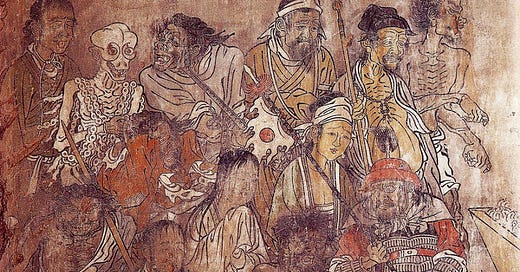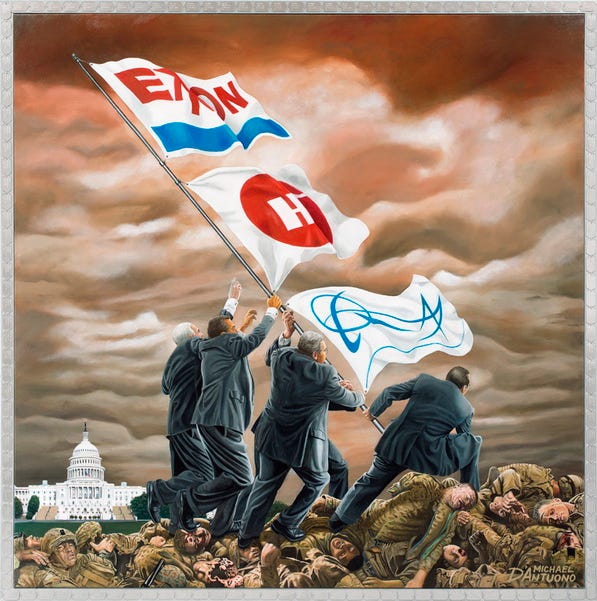Gravity's Rainbow - Part 3 - Chapter 2.1: The Halls of Death
Analysis of Gravity's Rainbow, Part 3 - Chapter 2.1: Slothrop Enters the Mittelwerke
Shoeless Slothrop is given, by Geli, a pair of Tchitcherine’s shoes, binding the two men further, as he makes his way toward the Mittelwerke. He is not the only one heading there. SPOG (Special Projectiles Operations Group) — Dennis Joint’s "adjunct of the British rocket-scavenging effort" (272) (2.8) — and American Army Ordinance people — the group working under Major Duane Marvy who arrived "to coordinate with some Project Hermes people from General Electric" (287) (3.1) — are all here for one purpose: for the “crating and shipping out [of] parts and tools for a hundred A4s […] before the Russians come to take over" (295). The Americans, British, and Russians have been working together up to this moment to liberate Germany and end the terror that the Axis powers have been casting over Europe. Now that it is purportedly over, the former two believe that Communist Russia has served its purpose. Similar to how PISCES and its rulers (Them) don’t want Russia to get their hands on Slothrop, the British and the Americans are doing whatever they can to retrieve and study the A4/V-2 rocket for themselves while leaving Russia with less than nothing.
Part of the purpose of The White Visitation’s study of Slothrop has been to better understand how the powers that be can propagandize Slothrop’s (or America’s, or the Coming World’s) view on violence, fetishizing it in a manner to increase profit and decrease the effect of the once apparent horrors. Despite the fact that The White Visitation lost Slothrop in Zürich, leaving them unable to fully complete their study, this does not mean that they weren’t at least partially successful. For as we now see in "One of many hustles […] an energetic businessman" arises, named Nick De Profundis, "selling A4 souvenirs" (295) to profit off of the coming rocket craze. A second hustle is shown by Oily Micro, who at first explains that the prisoners of the Dora Concentration Camp just outside of Nordhausen, the same prisoners whose slave labor was used to build the V-2 Rockets in the Mittelwerke, have raided the materials which they were forced to synthesize into those new forms of death never seen, leaving behind their spirits to haunt the factory. Oily Micro’s hustle then takes the unnamed visiting group through “the elegant Raumwaffe spacesuit wardrobe” (296). Within this wardrobe are literal space cowboy outfits designed from the same vein as the rockets and weaponry built during WWII. These products, similar to the A4 trinkets sold by Nick De Profundis, are a part of the emergence of the Raketen-Stadt — the Rocket City: a coming world being built up from the blank-slate of the Zone. It will be a world where every industry from television to fashion, storytelling to history, will be controlled by the Rocket — life borne out of synthesis, control, and death. If The Zone is the canvas, the coming Raketen-Stadt is Their finished masterpiece.
The Raketen-Stadt is a place which commits itself to “‘The Promise of Space Travel’” (297). This promise gives Them the pretense to commit any act They desire in the name of the mission, creating a system that no longer holds the symmetry or sensical nature it once did (even if that sense was derived from milder, though still present, forms of brainwashing and systemic corruption) and will instead introduce a Complexity and a Terror that keep the masses from either realizing that the Promise has far more nefarious and far-reaching intentions, or will keep them too afraid to do anything about it. And finally, through all these instances of a world being built from synthesized molecules and polymerized plastics, Imipolex G is called back. It is made from the polymerization of indoles — the substance used to synthesize LSD and other mind-altering substance, now treated like a reworkable plastic. This solidified substance is now placed within the Rocket itself, also solidifying, like Slothrop and the hustles in the Mittelwerke, the world built on death, profit, and control.
Slothrop, though he did not go on these tours through the Raketen-Stadt market, comes back now to traverse the Mittelwerke. The entrance to it “is shaped like a parabola,” (298) the pathway toward death itself — toward the Rocket City. The concept of the parabola may even bring about a “not-so-rare personality disorder known as Tannhäuserism,” (299) the attempted differentiation between sacred and profane love (i.e. love for the spirit and true being of the other versus a pure sensuous desire — the desire for that which the other can provide, sell, produce, give). And “Slothrop knows this place,” (299) for the profane love lies at the core of his map: lust that gives way to violence. But there are those unlike Slothrop — those who through the war have experienced the true horror, such as the Dora prisoners who earlier raided the Mittelwerke where they were enslaved, did not immediately go for the items which could provide them with sustenance and life, and instead looked for the glow of humanity.
The parabolic entrance leads to the shape of the two major tunnels themselves, “the letters SS each stretched lengthwise a bit” (299). The entrance to death, or Dante’s infernal vision, follows the shape of the Schutzstaffel1, a German paramilitary group which was responsible for the genocide and execution of a vast majority of the Jews and other groups deemed undesirable during the war. These tunnels, symbolizing the SS itself, are a revelation for one of the other less spoken about purposes of the holocaust — the revitalization of a slave state in which the slaves would be forced to create the weapons of their own, and humanity’s, destruction.
The SS is also the shape of the double integral. In calculus, an integral represents the area beneath a curve (often a parabolic curve or a section of). And if one were to bring the integrals into mechanical physics, taking the integral of an object’s acceleration (meters per second squared) would give you the object’s velocity (meters per second), and taking the integral of said object’s velocity — or the double integral of the original acceleration — would give you the object’s position (meters — from the starting position, or launching position, that is). Therefore, the shape of the tunnels which built the rockets not only represents the Schutzstaffel (SS), but also humanity’s inability of truly perceive said rocket; for, while the rocket itself “sensed acceleration first […] [m]en, tracking it, sensed position or distance first” (301). The rocket takes on a mind or life of its own. It is out of the hands of its creator once it is launched, and double integration is all that allows that creator to hold onto any perceivable sense of its future and its death. The rocket is, therefore, an evolution of human ability that has left the human behind — something we cannot comprehend with our own senses and therefore should never have been able to create.
Yet, humanity has surpassed itself in some sense — keeps surpassing itself (perhaps through the assistance of Blicero, Pökler, or one of the many other rocket scientists we’ve met), though certainly not infinitely. We have utilized tools and equations of the universe we may never have been meant to discover. They allowed us, to some extent, to control the rocket via some “so-called ‘IG’ guidance” (301) via the same double integration that we use to even understand how far it’s traveled. This SS allowed us to launch the rocket to the perfect Brennschluss point — the peak of the parabola, the Rainbow, where the engines will shut off to allow gravity to do the rest: at this moment, “The Rocket [is] on its own” (301), another point where humanity could not act as God. Perhaps in the future, even that point will be manipulable.
Further iterations of the meaning of SS come and go. First, through the mind of Etzel Olsch (the architect of the tunnels), who views it also as the symbol of death itself via ancient runes, similar to how the OSS viewed their organization’s name as “oss, the late, corrupt, Dark-age Latin word for bone” (2.7, pg. 268) — another perversion of the spirituality innate in humanity used to justify bringing hell to earth. Secondly, Slothrop himself views it as the shape of two bodies curled up in sleep, imagining him and Katje back at the casino. But why Katje now? All these thoughts of death, control, synthesis — why does it lead back to her? Despite Slothrop’s complex journey and rationalization for said journey, he does, like Roger, still possess that simple desire of love. A normal life.
Slothrop, here, for the first time, sees The Zone for what it truly is: the mess where life and death are intertwined, where the land is lawless, ready to be rebuilt according to Their rules. He sees ghosts that “used to be either likenesses of the dead or wraiths of the living. But here in the Zone categories have been blurred badly” (303). A world of Uncertainty. Though the one thing that is certain is what was done in the halls of the Mittelwerke, what was created with them, and what it has all led to. It has drawn Slothrop here, and whether or not the 00000 rocket was built in these halls, this world was not turned into the proverbial canvas out of nothing — it was all planned from the beginning.
Up Next: Part 3, Chapter 2.2
Though, if looking at this from a historical point of view, Pynchon does exaggerate this shape, the symbol remains.







